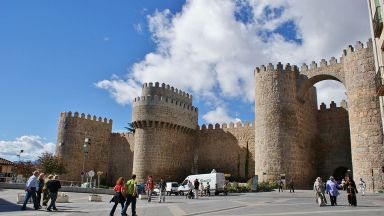El Convento de Santa Teresa
Convent in Ávila

The church was built on the house in which Teresa de Cepeda y Ahumada was born and is part of the Carmelite convent. Underground, the large vaulted burial crypt, which is currently used as the Museum of St Teresa, is the only example of its kind in Spanish religious architecture. The work was directed by the Carmelite architect Fray Alonso de San José and began in 1629. The building was opened on 15 October 1636.
In the purest Carmelite Baroque style, the church has a Latin-cross layout with a central nave and four chapels on each side. With the main altar in the northwest, it does not keep to established liturgical orientation as the presbytery was built to coincide with the room in which Teresa of Jesus was born. The entrance to the chapel of St Teresa opens up on the right arm of the transept and coincides with the area in which her family home once stood, together with the ‘small garden where the saint prayed’ opposite.
The front, which was designed in the style of an altarpiece, is separated into three bodies, giving prominence to the marble statue of the saint and the coats of arms of the Cepeda and Ahumada families, the Order of the Barefoot Carmelites, that of the Duke of Olivares, that of the Governor and that of Doctor of the Church.
Inside, the sculptures by Gregorio Fernández (17th century) and his school are of particular interest.
The plaza is also home to a room containing relics and remains and a small souvenir shop.
In 1886, the church and convent were designated a Historical Monument.
The El Convento de Santa Teresa appears in our Complete Guide to Visiting Ávila!
This website uses affiliate links which may earn a commission at no additional cost to you!
Visiting El Convento de Santa Teresa
Nearby Attractions
- Palacio de Núñez Vela (Ávila) (0.0) km
in Ávila - Puerta de Santa Teresa, Ávila (0.0) km
City Gate in Ávila - Palacio de Los Almarza (Ávila) (0.1) km
Palace in Ávila - Palacio de Los Superunda (Ávila) (0.1) km
Palace in Ávila - Palacio de los Guzmanes (Ávila) (0.1) km
Palace in Ávila - Palace of Polentinos (Ávila) (0.2) km
Historic Building and Palace in Ávila - Church of San Juan Bautista (Ávila) (0.2) km
Church in Ávila - Palacio de los Dávila (Ávila) (0.2) km
Palace in Ávila - Plaza Mercado Chico (0.3) km
Square in Ávila - Palacio de Benavites (Ávila) (0.3) km
Palace in Ávila


